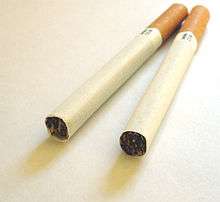Chain smoking
Chain smoking is the practice of smoking several cigarettes in succession, sometimes using the ember of a finished cigarette to light the next. The term chain smoker often also refers to a person who smokes relatively constantly, though not necessarily chaining each cigarette. The term applies primarily to cigarettes, although it can be used to describe incessant cigar and pipe smoking as well. It is a common form of addiction.[1]
Causes
The use of cocaine or an amphetamine with cigarettes can result in chain smoking.[2] Many people chain-smoke when drinking alcoholic beverages, because alcohol potentiates nicotinic acetylcholine receptors, leading to re-sensitization and hence inducing a craving.[3]
The extent to which chain smoking is driven by nicotine dependence has been studied. It does not seem that the amount of nicotine delivered is a significant factor, as the puff volume correlates poorly with the frequency of cigarette consumption.[4]
Clinical use
Chain-smoking is given as an example of excessive addictive behaviour in the Diagnostic and Statistical Manual of Mental Disorders.[5] It may be used as a form of aversion therapy for smokers who are unused to such heavy smoking, inducing them to give up altogether.[6]
Ventilation
Heating, ventilating, and air conditioning (HVAC) professionals claim that an airflow of about 1000 cubic feet (28.32 cubic meters) per minute per smoker is required to maintain satisfactory air quality when the smokers are chain smoking.[7] However, research confirms that current HVAC systems, while important for general air quality, cannot control exposure to secondhand smoke.[8]
See also
References
- Charles, Gerras (1976). The Encyclopedia of Common Diseases. Rodale Press. p. 17. ISBN 978-0-87857-113-0.
- Fisher, Gary L.; Roget, Nancy A. (11 November 2008). Encyclopedia of Substance Abuse Prevention, Treatment, and Recovery. SAGE Publications. ISBN 978-1-4129-5084-8.
- Rose, J.; Brauer, L.; Behm, F.; Cramblett, M. (2004). "Psychopharmacological interactions between nicotine and ethanol" (PDF). Nicotine & Tobacco Research. 6 (1): 133–44. doi:10.1080/14622200310001656957. PMID 14982697.
- Kolonen, S.; Tuomisto, J.; Puustinen, P.; Airaksinen, M. M. (1992). "Effects of smoking abstinence and chain-smoking on puffing topography and diurnal nicotine exposure". Pharmacol Biochem Behav. 42 (2): 327–32. doi:10.1016/0091-3057(92)90535-N. PMID 1631188.
- Helen, Keane (2002). What's Wrong with Addiction?. Melbourne University Publish. p. 100. ISBN 978-0-522-84991-2.
- Cocores, James (1991). The Clinical Management of Nicotine Dependence. Springer-Verlag. ISBN 978-0-387-97464-4.
- Rock, Brian A. (13 January 2006). Ventilation for Environmental Tobacco Smoke. Elsevier Science. p. 48. ISBN 978-0-08-052539-6.
- U.S. Department of Health and Human Services (2006). The Health Consequences of Involuntary Exposure to Tobacco Smoke: A Report of the Surgeon General (PDF). p. 92. Archived (PDF) from the original on 2009-02-05.
